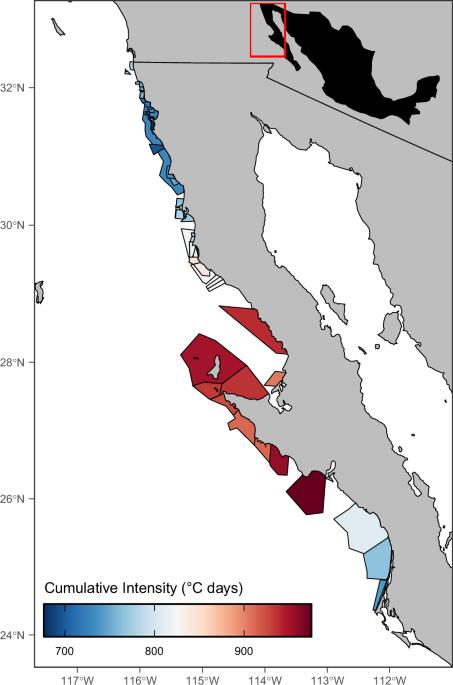海洋热浪过去和未来对墨西哥下加利福尼亚小型渔业的影响
IF 8.1
1区 地球科学
Q1 ENVIRONMENTAL SCIENCES
引用次数: 0
摘要
海洋热浪是全球性事件,会对渔业产生负面影响,但其对小型渔业的影响仍未得到充分研究。我们研究了海洋热浪对墨西哥下加利福尼亚半岛生物地理过渡区小型渔业的历史和未来影响。我们估算了有记录以来最强烈的海洋热浪对在 55 个渔业领土使用权系统中作业的 43 个经济单位的渔业生产的影响。在这一期间,龙虾、海胆和海参渔业的总上岸量减少了 15% 到 58%。大多数作业(56%)的上岸量大幅减少,其损失超过了其他 44%作业的少量增加。值得注意的是,在赤道生物地理断裂带附近作业的渔业,以及在历史环境变化大、渔业生产历史变化小的地区作业的渔业,受到的影响更大。气候模型预测,所有渔业受海洋热浪影响的频率和强度都会增加,但北部渔业受影响的频率和强度变化会更大。面对海洋热浪等极端环境冲击,在生物地理过渡区附近作业的小型渔业是最脆弱的。根据对渔业数据和海面温度的分析,过去二十年间,强烈的海洋热浪导致下加利福尼亚半岛龙虾、海胆和海参等小型渔业上岸总量减少高达 58%。本文章由计算机程序翻译,如有差异,请以英文原文为准。

Past and future impacts of marine heatwaves on small-scale fisheries in Baja California, Mexico
Marine heatwaves are globally occurring events that can negatively impact fisheries, but their impacts on small-scale operations remain understudied. We investigate the historical and future impacts of marine heatwaves on small-scale fisheries operating along a biogeographic transition zone in the Baja California Peninsula, Mexico. We estimate the impacts of the most intense marine heatwave regime on record on fisheries production of 43 economic units operating in a system of 55 Territorial Use-Rights for Fisheries. During this regime, aggregate landings in the lobster, sea urchin, and sea cucumber fisheries decreased between 15 and 58%. Most operations (56%) presented large reductions in landings, whose losses more than outweigh the small increase detected for the other 44%. Notably, impacts were larger for fisheries operating near an equatorward biogeographic break, and for operations in areas of high historical environmental variation and low historical variation in fisheries production. Climate models predict an increase in the frequency and intensity of exposure to marine heatwaves for all fisheries, but the change in frequency and intensity will be greater for those in the north. In the face of extreme environmental shocks such as marine heatwaves, small-scale fisheries operating near biogeographic transition zones are among the most vulnerable. Intense marine heatwaves led to a reduction in aggregate small-scale fisheries landings of lobsters, sea urchins and sea cucumbers of up to 58% during the last two decades in the Baja California Peninsula, according to an analysis of fisheries data and sea surface temperatures.
求助全文
通过发布文献求助,成功后即可免费获取论文全文。
去求助
来源期刊

Communications Earth & Environment
Earth and Planetary Sciences-General Earth and Planetary Sciences
CiteScore
8.60
自引率
2.50%
发文量
269
审稿时长
26 weeks
期刊介绍:
Communications Earth & Environment is an open access journal from Nature Portfolio publishing high-quality research, reviews and commentary in all areas of the Earth, environmental and planetary sciences. Research papers published by the journal represent significant advances that bring new insight to a specialized area in Earth science, planetary science or environmental science.
Communications Earth & Environment has a 2-year impact factor of 7.9 (2022 Journal Citation Reports®). Articles published in the journal in 2022 were downloaded 1,412,858 times. Median time from submission to the first editorial decision is 8 days.
 求助内容:
求助内容: 应助结果提醒方式:
应助结果提醒方式:


